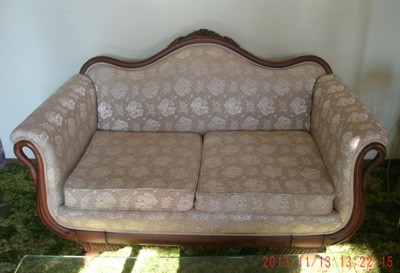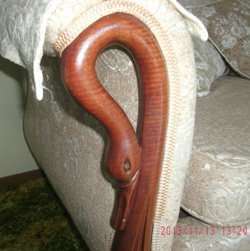 |
|
|||
 |
 |
|||
RINKER ON COLLECTIBLES — Column #1403 Copyright © Harry Rinker, LLC 2013
Questions
and Answers
QUESTION: I have a French Provincial loveseat. I was told it was made in France or possibly Quebec, Canada, in the 1880s. Around 1900, my aunt purchased the loveseat in Toronto, Canada, and gave it to my mother in 1960. Shortly thereafter, she had it reupholstered in Collingwood, Ontario. It has been in my possession since 1990. The loveseat is in very good condition and has no nicks or scratches. What is my loveseat’s value? – HR, Cortland, OH, Email Question
ANSWER: French Provincial is a term used to describe furniture made in provincial cities and towns such as Blois, Orléans, and Lyon (Liége) and which followed the design styles popular in Paris to a modest degree. Cabriole legs and simple scalloped carving are typical furniture elements. The “Country” version of the furniture often is painted white. The origin of the design style dates from the 1780s through the 1830s/1840s. French Provincial also is a term used by commercial furniture companies to describe furniture made in a simplified French taste. These late 19th century and early 20th century pieces often contained a mixture of design elements from different historical design periods.
The carving and other elements of the loveseat’s wood frame confirm the piece is factory made. Given this, a Canadian/American origin is far more probable than a French one. Assuming the family provenance is correct, the manufacturing date is somewhere between 1890 and 1910.
Your late 19th century/early 20th century loveseat has a retail secondary market value between $350.00 and $400.00. If you want to sell it, consider any offer above $200.00. QUESTION: When I was young, my family owned a Camp Granada boxed board game. I have what remains – a badly damaged box, the game board, and the toy bus. The animals are missing. I would like to know more about the origins of the game and what it might cost to buy a complete example. – J, Eagan, MN ANSWER: The website www.boardgamegeek.com is the place I turn to when seeking information about a board game. Milton Bradley introduced Allan Sherman’s Camp Granada Game, designed by Reuben Klamer, in 1965. The game consisted of a game board, 16 Icky animal cards, 48 camp bus cards, 4 bunk houses with roofs, a camp bus, and 12 rubber animals. The game board introduced the players to Camp Granada’s Cruddy Creek, Quicksand Beach, and Brawl Park. Each player sets up one of the bunk houses near the game board. The animals are placed on red spaces on the board. Each player draws three icky animal cards. The player moves the bus as far as he/she can, ideally capturing one or more of the animals during the turn. When the bus breaks down, something that happened if the wheels were not kept straight, the player loses his/her turn. The goal is to collect three animals and exit the camp. Allan Sherman (November 30, 1923 to November 20, 1973) was a comedy writer and television producer who became famous for his song parodies. His 1962, 33 1/3 long play album entitled “My Son, the Folk Singer” sold over one million copies. In the summer of 1963, Sherman’s single “Hello Muddah, Hello Fadduh,” a spoof of a summer camp letter, was No. 2 on the Billboard Hot 100 chart for three weeks. The opening stanza reads: “Hello Muddah, hello Faddah, Here I am at Camp Granada Camp is very entertaining And they say we’ll have some fun if it stops raining.” [For more information see: http://en.wikipedia.org/wiki/Allan_Sherman] TRIVIA QUIZ: For what popular Goodson-Todman Productions quiz show, hosted by Gary Moore and later Steve Allen, did Sherman conceive the idea and produce from 1952 to 1958? Finding a complete example of the 1965 Milton Bradley Camp Granada game is not easy but possible. Do not fall into the trap of buying multiple games in hopes of assembling a complete game. Be patient until a complete game comes on the market. Expect to pay between $35.00 and $45.00, shipping costs included. QUESTION: I have a 1928 Gibson tenor Mastertone banjo that I want to sell. Looking on the internet, I found asking prices for Gibson Tenortone banjos ranging from $4,000.00 to $8,000.00. I talked with two guitar dealers who asked me to send pictures. A private individual visited my home and offered $4,000.00. What is your advice? – P, Bozman, MT ANSWER: “Kiss the hand. Take the money. Go to church. Light a candle. Thank God.” Doing detailed research about your banjo is critical to your ability to sell it. Start by visiting the website www.earnestbanjo.com. It contains detailed information on Gibson’s Mastertone banjos. For example, the 1928 section contains listings for eight different models. Model is a key component in value. If you decide to pursue a guitar appraisal, make certain you understand upon what value the appraisal is based. Most appraisers use a retail replacement value. This is a far different value than what you would receive if placing your banjo at auction or selling to a dealer. Should you wish to pursue this avenue, I recommend you consider using Gruhn Guitars, 2120 8th Avenue, Nashville, TN 37204 (www.gruhn.com). Every dealer or private individual attempting to buy an antique or collectible hates to be the first person through the door, especially if the seller’s position is “make me an offer.” Most potential buyers know (1) that this is tantamount to asking for a free appraisal and (2) it is highly unlikely that the person will take the offer. Why then is an offer made? The answer is an inherent mistaken belief that “this time will be different.” It almost never is. The seller hears the offer and immediately thinks, “if this person is willing to pay me this much, the next will probably offer more.” This also is an invalid assumption. “The first 20 dollars is easy; the last 20 dollars is hard” is an antiques and collectibles trade truism. You have a firm $4,000.00 offer. You have no intention of playing the banjo. String instruments stored over a long period of time lose value. They need to be played to maintain value. How much more time, effort, and expense are you willing to expend to obtain an extra $500.00 or $1,000 dollars? Consider the possibility that an appraisal may not support the initial offer. Finally, if you decide to take the $4,000.00 offer, the buyer may no longer be prepared to honor it. If I was the buyer, I would think like this: “The owner shopped the banjo around and could find no one who would better my offer. There is no reason why I should honor it either. The owner already has rejected it. If the owner wants me to buy it now, he/she is going to have to take less.” In conclusion, everyone wants the maximum amount for what they sell. It is only natural. It also is a mistake. Even if the price is not quite what you expect, selling makes sense. You have the cash. The person who bought the object now has the “selling” problem. It is more fun to count cash than blessings. TRIVIA QUIZ ANSWER: “I’ve Got A Secret”Harry L. Rinker welcomes questions from readers about
collectibles, those mass-produced items from the twentieth and twenty-first centuries.
Selected letters will be answered in this column.
Harry cannot provide personal answers.
Photos and other material submitted cannot be
returned.
Send your questions to: Rinker on Collectibles, 5955 Mill
Point Court SE, Kentwood, MI 49512.
You also can e-mail your questions to
harrylrinker@aol.com.
Only e-mails containing a full name and mailing address
will be considered.
You can listen
and participate in
WHATCHA GOT?, Harry’s
antiques and collectibles radio call-in show, on Sunday mornings between 8:00 AM
and 10:00 AM Eastern Time.
If you
cannot find it on a station in your area,
WHATCHA GOT?
streams live on the Internet at www.gcnlive.com.
SELL, KEEP OR TOSS?: HOW TO DOWNSIZE A HOME,
SETTLE AN ESTATE, AND APPRAISE PERSONAL PROPERTY
(House of Collectibles, an imprint of Random House Information Group, $17.99),
Harry’s latest book, is available at your favorite bookstore and via
www.harryrinker.com.
|
||||

 Your loveseat is an example. The rosette carving in the crest is typical of late 19th century Rococo Revival pieces. The basic shape is Empire Revival as are the winged duck feet. The swan’s neck arms are identical to those found on late 19th and early 20th century generic rocking chairs.
Your loveseat is an example. The rosette carving in the crest is typical of late 19th century Rococo Revival pieces. The basic shape is Empire Revival as are the winged duck feet. The swan’s neck arms are identical to those found on late 19th and early 20th century generic rocking chairs. Your mother selected a nice fabric pattern for the reupholstering. Assuming wear is minimal, the piece is in “room ready” condition. If it was not, the cost to reupholster a second time would factor into the resale value of the piece as it stands. Individuals selling furniture that requires reupholstering have to accept the fact that the only value inherent in the piece is that of the frame. A potential buyer is going to calculate (1) the cost to reupholster the frame and (2) the value of the piece after reupholstering, subtract 1 from 2, and not pay more than the difference, preferably less.
Your mother selected a nice fabric pattern for the reupholstering. Assuming wear is minimal, the piece is in “room ready” condition. If it was not, the cost to reupholster a second time would factor into the resale value of the piece as it stands. Individuals selling furniture that requires reupholstering have to accept the fact that the only value inherent in the piece is that of the frame. A potential buyer is going to calculate (1) the cost to reupholster the frame and (2) the value of the piece after reupholstering, subtract 1 from 2, and not pay more than the difference, preferably less. Your loveseat’s primary value is reuse. It has minimal decorator/conversation value and no collector value. Modern French Provincial loveseats are priced upward from $900.00, with an average price of approximately $1,750.00. eBay contains dozens of listings of used examples, ranging in price from a low of $300.00 to $1,200.00.
Your loveseat’s primary value is reuse. It has minimal decorator/conversation value and no collector value. Modern French Provincial loveseats are priced upward from $900.00, with an average price of approximately $1,750.00. eBay contains dozens of listings of used examples, ranging in price from a low of $300.00 to $1,200.00.